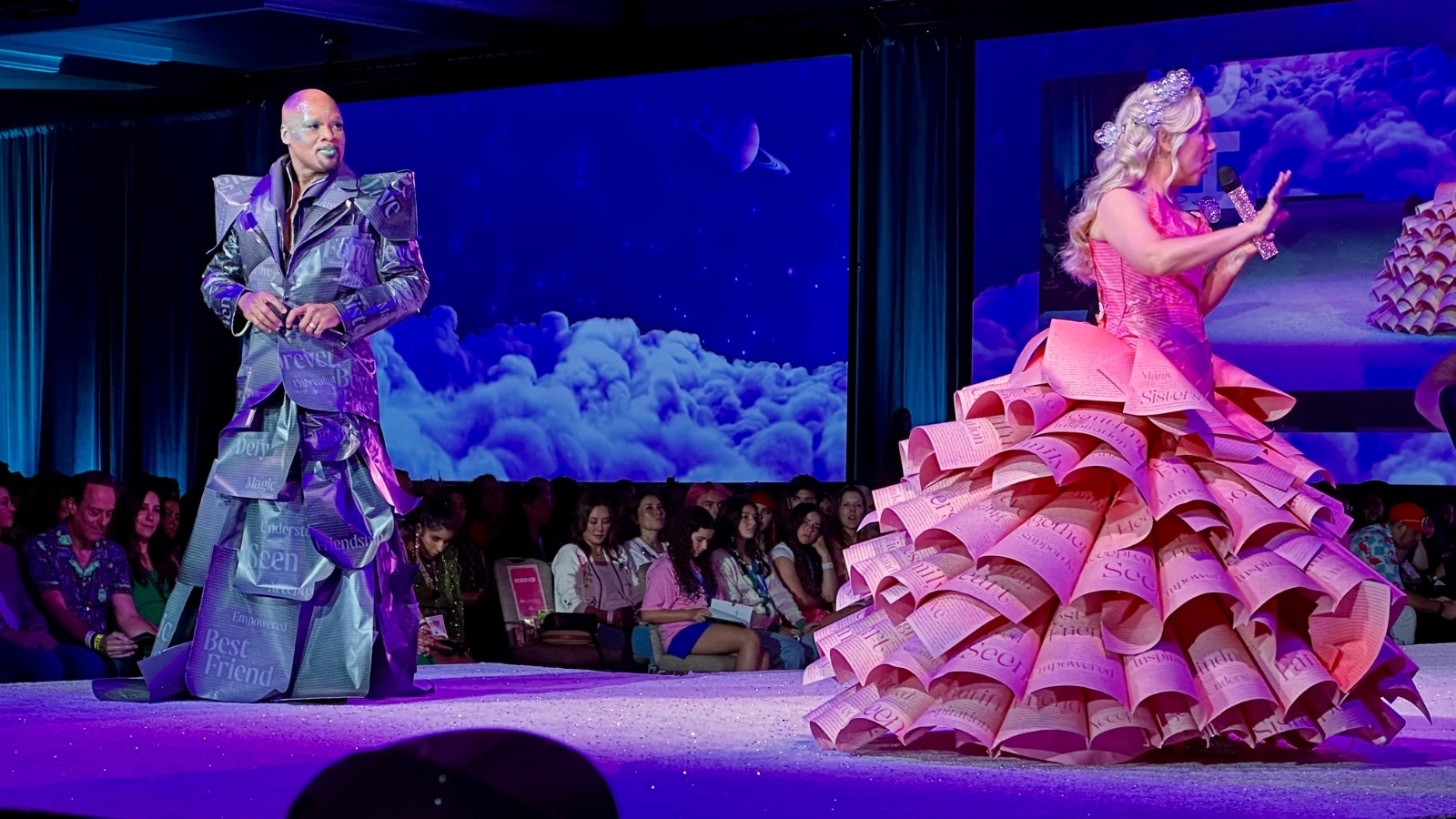In this week’s luxury briefing, we dive into how luxury fashion is approaching a post-“Challengers” tennis fashion landscape at Wimbledon and beyond. Also, why casualization is happening in men’s fashion, what products luxury customers are actually buying, executive moves, the latest Glossy Podcast and news to know. For any tips or comments, you can reach me at zofia@glossy.co.
Wimbledon is currently underway in London — the 2025 tournament runs from June 30 to July 13.
This year’s edition arrives as luxury consumers, and luxury brands, are shifting their approach to tennis style. Where overt tenniscore once dominated, the most directional pieces this season are more subversive and subtle.
For example, Thom Browne’s March womenswear show in Paris featured a sharply structured corset embroidered with crossed tennis rackets. Priced at $2,390 and styled with a pleated skirt and a miniature bag, it nodded to the sport without mimicking it.
Meanwhile, tennis player Coco Gauff, brought high fashion onto the court: In May, she wore Miu Miu x New Balance matchwear at the Italian Open. The navy-toned, double-layer pleated skirt and custom CG1 sneakers worked on the court without shouting “tennis club.”
As for Miu Miu x New Balance, Miu Miu brings fashion capital, while New Balance offers credibility from within the sport. For sporty luxury shoppers, it offers an understated flex similar to Loewe’s partnership with On, which felt elevated and wearable far beyond the court. On partnered with Roger Federer on the tennis shoe development. The Miu Miu x New Balance collection will be available online and in select Miu Miu stores starting September 10.
While traditional “sporty and rich” styling — think: crisp whites, pleated skirts and old-money crests — still circulates widely, it’s also become ubiquitous. Amanda Greeley, founder of the Charleston-based tennis brand Spence, is among those now seeking alternatives. “I’m drawn to the rhythm and elegance of the game,” she said, “but I don’t want to just replicate a costume. There’s room for more creativity, more real life.”
Launched in March, Spence is part of a new guard of brands building a more refined tennis wardrobe for on and off the court. During Wimbledon, Spence is hosting a residency at the high-end running brand Tracksmith’s London store, debuting a “SportLace” capsule collection. The capsule is composed of machine-washable lace garments, designed in collaboration with an Italian textile mill that also supplies Chanel, according to the company. Inspired by Billie Jean King and Chris Evert, the pieces are built to move but styled to live in. Prices range from $50-$200.
“We’re not streetwear,” said Greeley, “but we take cues from how surf and skate brands reflect real life. The sweatshirt you wear to hit balls should be the one you also want to wear to lunch.” According to Greeley, Spence reflects “the sensibility of Phoebe Philo, with the utility of early Outdoor Voices and the quiet confidence of Carolyn Bessette.” Spence’s customers would rather take inspiration from what editors and stylists wear on the court than buy into a saturated trope, she said. On Instagram, its main marketing channel, Spence showcases quotes from avid tennis fans like Eric Clapton alongside editorial campaign shots and ’80s-inspired imagery.
Morgan Riddle (437,000 Instagram followers), co-host of Wimbledon’s official “Wimbledon Threads” video series and girlfriend of tennis player Taylor Fritz, is embracing a less traditional tennis look, as well. “There are girls who take up tennis just because they want to wear the outfits,” she said. “But I don’t know if the world needs another tennis skirt. I want to see more spectator fashion — clothes that make a statement, whether or not you ever pick up a racket.”
Riddle said brands like Thom Browne, Miu Miu and Spence feel modern because they’re pulling tennis into their own design worlds, not just replicating retro looks.
“The ‘tennis club’ aesthetic is definitely at risk of overexposure,” said Christopher Morency, chief brand officer of agency group Dogma and founder of brand strategy firm Dot Dot Dot Partners. “It’s become a quick visual shortcut for luxury, but when brands just treat it like a trend, it loses its edge. To keep it aspirational, it has to go deeper than lookbooks and courtside moments.”
Even Wimbledon fashion is evolving. Sales through the event’s e-commerce shop rose 54% year over year from January to May, according to data from the All England Lawn Tennis Club organization. In response, the All England Club expanded its No.1 Court store and launched a 174-piece “Court to Club” capsule, featuring ecru denim jackets, striped joggers and tonal caps. Prices range from £10 to £155 ($13-$196). According to AELTC research, 70% of Gen Z and millennials already own tennis-inspired clothing, and 57% say they follow the trend.
Luxury fashion houses are also watching. On June 26, Gucci hosted a private dinner at Claridge’s hotel to mark tennis player Jannik Sinner’s new Association of Tennis Professionals World No. 1 ranking. The brand’s 2024 campaign with Sinner, a brand ambassador, featured a tennis capsule collection, sold globally, and a Piccadilly Circus takeover, which generated $1 million in media impact value in 48 hours, according to social media marketing data company Launchmetrics. The company also reported that Wimbledon 2024 generated $873 million in MIV, with fashion and celebrity content as primary drivers.
Until recently, luxury tennis fashion was often aspirational-only. Chanel’s spring 2017 racket and Gucci’s courtside tennis looks rarely made it to retail until recently. Exceptions like Lacoste’s more fashion-forward drops and Kiton’s June 2024 capsule were rare. Now, the new luxury customer doesn’t want to dress like a player or an old-money tennis club member — they just want to look like someone who plays, but doesn’t need to prove it.
“[The appetite for tennis] is not slowing down, especially with Gen Z,” Riddle said.
The ‘casualization’ of menswear is catching on
Luxury consumers today are increasingly drawn to versatility and ease.
That is being felt across luxury menswear, including at the just-wrapped Paris Men’s Fashion Week, where brands traditionally known for formality leaned further into dressed-down codes. For example, Jonathan Anderson’s Dior collection featured undone trainers, utilitarian cargo shorts and trousers with pleats inspired by the Dior Delft dress.
“There’s definitely a shift happening in how men want to express themselves, but that’s been going on for the past decade,” said Christopher Morency, chief brand officer of agency group Dogma and founder of brand strategy firm Dot Dot Dot Partners. “It’s less rigid, more expansive, and more playful with proportion and function.”
Meanwhile, Louis Vuitton’s runway during PFWM, which focused on everyday ease and laid-back layering, was criticized by some commentators as “boring,” pointing to industry backlash as casualization becomes the new normal.
Canali, which presented its spring 2026 collection the week prior, in Milan on June 22, has been on this path for years. Its concept of “Whispered Luxury” is not a reaction to market pressures but a long-term strategy grounded in consistency. “In times of uncertainty, clients reward brands that offer substance: integrity in materials, excellence in construction and a design language that’s discreet yet distinctive,” said Stefano Canali, CEO of the brand. “Today’s customers recognize and reward this approach.”
Canali’s spring 2026 collection took inspiration from the golden age of Grand Turismo racing and the industrial elegance of Monza, near Canali’s home in northern Italy. It featured automotive-inspired details including textures subtly nodding to leather interiors and mechanics’ uniforms.
Even as the broader luxury sector faces slowed growth and shifting consumer sentiment, Canali has continued to outperform expectations in its top market, the U.S., where it is experiencing strong double-digit growth. In Europe, longstanding brand loyalty provides stability, while China and parts of Asia remain longer-term investments as they experience short-term economic headwinds.
What are luxury customers actually buying?
Glossy got an exclusive dive into what luxury customers are actually buying with Plot, an AI social media company that analyzes what is seen, said and shown in video, and shares insights with brands. The following content was compiled from the last two weeks of fashion posts on Instagram and TikTok.
- Handbags account for 64% of luxury mentions. Top brands include Louis Vuitton (5,000+ mentions) for its monogram, hardware and broad appeal; Hermès for its exclusivity, craftsmanship and investment value; and Chanel for its beauty products, jewelry and status-symbol fashion.
- On the rise are Coach for its heritage and accessible pricing; Loewe for its design-led styles like the Puzzle bag; and D&G and Givenchy for their bold, Gen Z-friendly aesthetics.
- Purchase drivers for customers, according to their videos, are brand legacy, status and resale value. When it comes to newer brands, the focus is on price and personalization.
- According to the data, Gen Z and millennials are fueling the rise of “affordable luxury” via TikTok and Instagram hauls.
Executive moves
- Holt Renfrew CEO Sebastian Picardo is stepping down on September 30 and relocating to London, citing family reasons and new opportunities. A global search for his successor is in advanced stages. Picardo, who joined Holts in 2020, led major transformation efforts, expanding accessible luxury, revamping digital and reinforcing sustainability to solidify the retailer’s position as Canada’s leading luxury destination.
- Lacoste has named Éric Vallat as its new CEO, effective September 1, as the brand eyes its next phase of global growth. Vallat, most recently CEO of Rémy Cointreau and formerly of Richemont and Louis Vuitton, will succeed Thierry Guibert, who remains CEO of parent company MF Brands Group.
News to know
- Rick Owens is launching an OnlyFans for his feet, calling it a playful protest against moralism and a reflection on aging.
Listen in
On the latest Glossy podcast, senior fashion reporter Danny Parisi and editor-in-chief Jill Manoff break down NBA Draft fashion trends, Skims’s Y2K-inspired swim collab with Roberto Cavalli, and the rise of men’s sandals at Paris Men’s Fashion Week. Plus, international reporter Zofia Zwieglinska talks with Daydream co-founder Lisa Yamner Green about how AI is reshaping the future of online shopping through smarter, more intuitive discovery.
Read on Glossy
Sabrina Carpenter’s videos are the new way for brands to launch products. How IWC and Pacsun got in on the F1 craze. Dior’s book tote is getting a reinvention.


